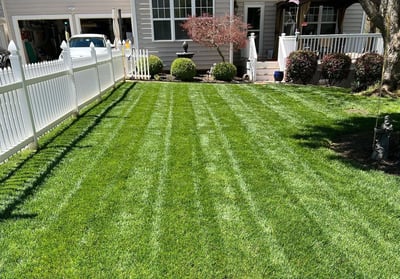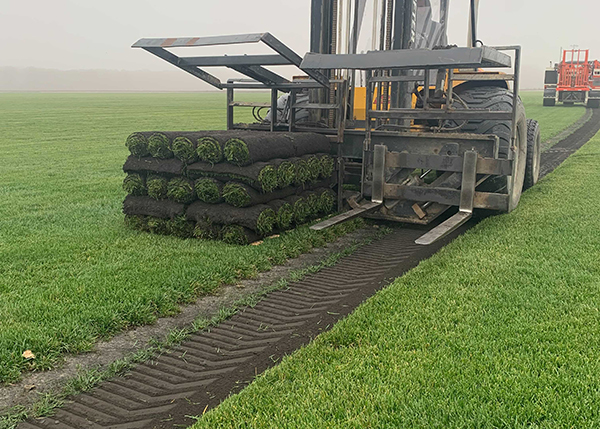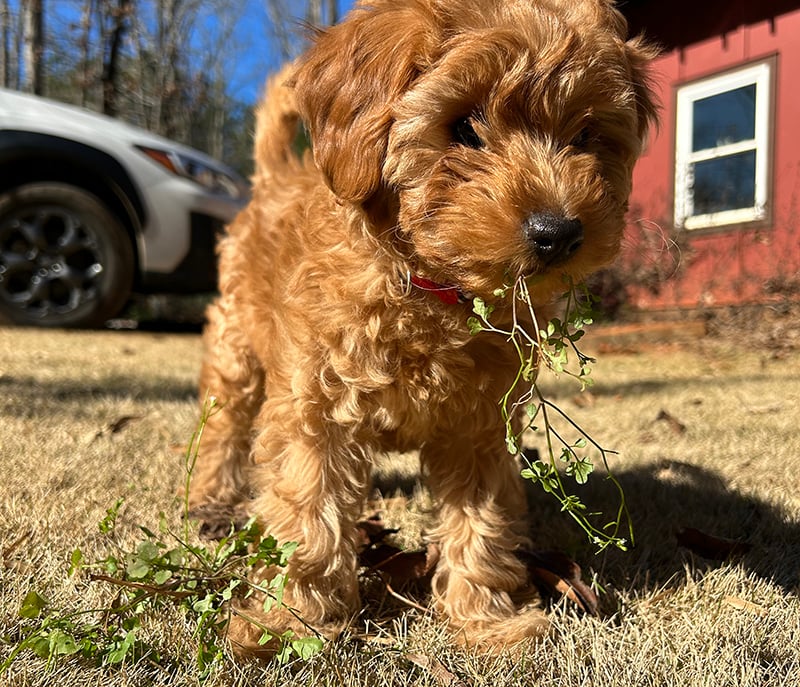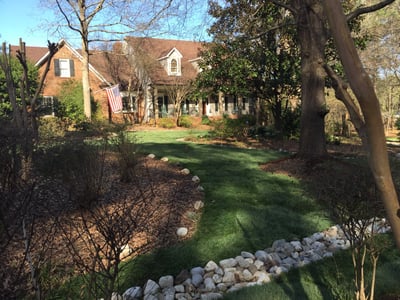

The cool months ahead are prime-time growing for Tall Fescue lawns. To be honest, no Tall Fescue lawn care tips have changed since December, but here they are for your convenience. Keep up these solid lawn care habits!
☃️ If you put Christmas inflatable decorations on your lawn or lit fireworks that did some damage, read up on how to repair your lawn after Holiday festivities. Read more on Lawn Care for Inflatables and Fireworks During Winter Holidays.
Overseeding & Laying Sod
It's still a great time to lay Tall Fescue sod! Get instant impact with Elite Tall Fescue sod, available as a single roll or in full pallets. The picture above shows us harvesting Tall Fescue sod at one of our North Carolina farms.
💻 You can order rolls or pallets of Tall Fescue in our store.
The window has closed until September for overseeding Tall Fescue lawns with fresh seed. If you regret missing that window, consider ordering a pallet or individual rolls to patch bare areas.
Dig into why we recommend laying new sod with Soil³ by reading this short article: Laying New Sod with Soil³.
Rake or Blow Leaves off ALL Lawns
This should have been done in December; so if you haven't done it yet, remove leaves from your Tall Fescue lawn to prevent suffocation and diseases. Rake or blow them into your beds and natural areas to use them as mulch rather than bagging them. Leaves are also a good addition to the compost pile.
👉 Read more about Using Fall Leaves in the Garden.
Fertilizing Tips for Tall Fescue Lawns
- Stop in to pick up 16-4-8 fertilizer for Elite Tall Fescue lawns through the cool growing season. Review the fertilizing schedule in our Tall Fescue Maintenance Guide.
- Check out our Lawn Coach subscriptions for Tall Fescue products.
- Along with fertilization, you may need to apply a fast-acting lime that neutralizes the pH of your soil. Always take a soil test to confirm if you need to apply lime or fertilizer. Balanced soil pH is critical for your grass to be able to use the nutrients supplied by your fertilizer.
💦 Watering Tips for Tall Fescue Lawns
-
Even thought it's winter, if you have recently laid new sod, keep your sprinkler handy and turn it on to keep new sod moist until roots form.
-
After your new sod or newly overseeded lawn is rooted in, you'll be able to back off watering to 1" per week during the cool months ahead.
Weeding Tips for Tall Fescue Lawns
- Clare Lewis, Customer Experience Leader for Lawn Coach, wrote a piece to help you manager the winter weeds you're seeing right now. Read Tackling Winter Weeds.
- Weeds in Established Tall Fescue lawns: Weather permitting, now is also the time for post-emergent liquid herbicides like Quincept and 3-Way Max for weeds you can see now in established Tall Fescue lawns. These post-emergents work best above 65 degrees so they will work if we have any other extended warm spells like we did in December. Read the label and follow instructions.
- Weeds in New Tall Fescue Lawns: If you planted Tall Fescue seed or laid new sod and in the process tilled up existing soil, you've probably kicked up weed seeds and exposed them to the light. As a result, the weeds are probably germinating alongside your Fescue seedlings.
- 👍 Rule of Thumb: It's okay to apply a post-emergent liquid herbicide labeled for Tall Fescue lawns (Quincept and 3-Way Max) after you've mowed your new lawn 3 to 4 times.
- Another method to combat weeds is to mow them before they go to seed. Mowing is an effective way to suppress weeds because it cuts off flower/seed heads and that stops weeds from making more weeds, thus breaking the life cycle. If you have bad winter weeds, mow on a weekly routine and don't let the weeds get ahead of you.
- The window for applying pre-emergent herbicide for summer weeds will open next month when the Forsythia bushes flower. We'll send you a reminder email alert at that time. Sign up for Lawn Coach and we'll ship you pre-emergent when it's time.
- Mulch is a time-tested trick for suppressing weeds in flower beds. Spread bark or pine straw 2-4" thick and keep it 1-2" away from touching the trunks or stems of your plants. Rake/blow leaves off your lawn and into your beds and natural areas rather than bagging them.
- Hand weeding gets you outside! If you spend a lot of time in front of screens, hand pulling those winter weeds is a good motivator to get out for some Vitamin D therapy.
Featured Weed - Bittercress
I'm already seeing hairy bittercress flowers and, not only that, a few are even producing seeds! This is earlier than I've ever seen them seeding, probably because of the mild December temperatures.
Click here to learn all about hairy bittercress and why I don't worry about my pup Rosie "helping" me while I hand weed some stray bittercress out of my Zoysia.

Mowing Tips for Tall Fescue Lawns
- Mowing Tall Fescue Seedlings: The first time to mow a new Tall Fescue lawn (at a 2.5-3" cut height) is when it reaches 3-4" tall. In fact, mowing will promote growth! So don't be timid. Mow it! Read: How Soon Should I Cut My Grass?
- If you haven't already lowered the mower blade for your established Tall Fescue lawn, do it now during the cool season. Continue to mow as needed throughout the winter at a 2.5-3" cut height. This summer we'll remind you to raise it up again.
- Mowing Frequency: We recommend mowing every 5 to 7 days when Tall Fescue is actively growing during the cool months.
Come back next month for February Lawn Tips for Tall Fescue lawns!
For tips on what to do for Warm Season lawns such as Bermuda, Centipede, Zoysia, take a gander at this page: January Warm Season Lawn Tips.
Got questions? Leave a comment below!
New here? Subscribe to our emails to get this information in your inbox every month.






